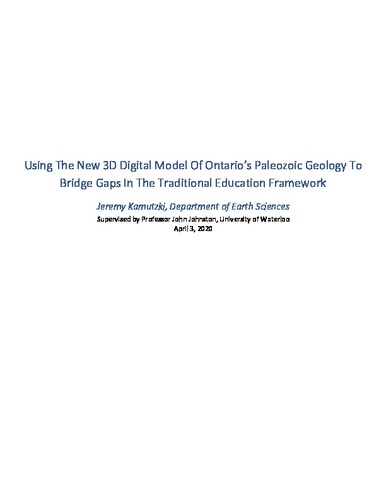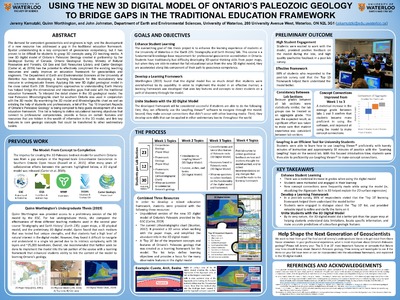| dc.contributor.author | Kamutzki, Jeremy | |
| dc.date.accessioned | 2020-04-13 16:25:54 (GMT) | |
| dc.date.available | 2020-04-13 16:25:54 (GMT) | |
| dc.date.issued | 2020-04-13 | en |
| dc.date.submitted | 2020-04 | |
| dc.identifier.uri | http://hdl.handle.net/10012/15747 | |
| dc.description.abstract | The demand for competent geoscientists and engineers is high, and the development of a new resource has addressed a gap in the traditional education framework. Spatial understanding is a key component of geoscience competency, but it has proven to be difficult for students to grasp 3D concepts using 2D teaching media. A new 3D digital model of Ontario’s Paleozoic Geology created in partnership by the Geological Survey of Canada, Ontario Geological Survey, Ministry of Natural Resources and Forestry, Oil Gas and Salt Resources Library, and Carter Geologic (Carter et al., 2019) has the potential to effectively compliment the existing teaching resources and vastly improve an education framework for geoscientists and engineers. The Department of Earth and Environmental Sciences at the University of Waterloo has been developing a teaching framework for this revolutionary new resource in undergraduate theses. Applying this new 3D digital geological model in the class called ‘Earth 235: Stratigraphic approaches to understanding Earth History’ has helped bridge the dimensional and interactive gaps that exist with the traditional education framework. To interpret the detail shown in the 3D geological model, the new Paleozoic lithostratigraphic chart for southern Ontario was used in conjunction with the 3D model. By examining the 3D model and lithostratigraphic chart as well as enlisting the help of students and professionals, a list of the ‘Top 10 Important Aspects of Ontario’s Paleozoic Geology’ is being compiled to help guide development of a new education framework. This list is helping to define educational learning objectives that connect to professional competencies, provide a focus on certain features and resources that are hidden in the wealth of information in the 3D model, and link key features to core geologic concepts that could be transferred to other sedimentary basins. | en |
| dc.language.iso | en | en |
| dc.publisher | University of Waterloo | en |
| dc.relation.ispartofseries | EARTH 436B PRJ, Honours Thesis | en |
| dc.subject | geoscience | en |
| dc.subject | paleozoic geology | en |
| dc.title | Using The New 3D Digital Model Of Ontario’s Paleozoic Geology To Bridge Gaps In The Traditional Education Framework | en |
| dc.type | Bachelor Thesis | en |
| uws-etd.degree.department | Earth and Environmental Sciences | en |
| uws-etd.degree.discipline | Earth Sciences | en |
| uws-etd.degree | Bachelor of Science | en |
| uws.contributor.advisor | Johnston, John | |
| uws.contributor.affiliation1 | Faculty of Science | en |
| uws.published.city | Waterloo | en |
| uws.published.country | Canada | en |
| uws.published.province | Ontario | en |
| uws.typeOfResource | Text | en |
| uws.peerReviewStatus | Unreviewed | en |
| uws.scholarLevel | Undergraduate | en |


